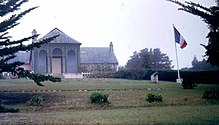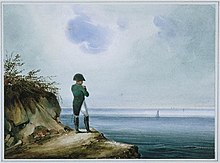Napoleon was imprisoned and then exiled to the island of Saint Helena in the Atlantic Ocean, 2,000 km from any major landmass. In his first two months there, he lived in a pavilion on the Briars estate, which belonged to a William Balcombe. Napoleon became friendly with his family, especially his younger daughter Lucia Elizabeth who later wrote Recollections of the Emperor Napoleon. This friendship ended in 1818 when British authorities became suspicious that Balcombe had acted as an intermediary between Napoleon and Paris and dismissed him from the island.

Scene in Plymouth Sound in August 1815, by John James Chalon. Pictured is HMS Bellerophon with Napoleon aboard, shortly before his transferral to HMS Northumberland for delivery to Saint Helena

Longwood House, Saint Helena: site of Napoleon's captivity
In 1818, The Times reported a false rumour of Napoleon's escape and said the news had been greeted by spontaneous illuminations in London.There was sympathy for him in the British Parliament: Lord Holland gave a speech which demanded the prisoner be treated with no unnecessary harshness. Napoleon kept himself informed of the events through The Times and hoped for release in the event that Holland became prime minister. He also enjoyed the support of Lord Cochrane, who was involved in Chile's and Brazil's struggle for independence and wanted to rescue Napoleon and help him set up a new empire in South America, a scheme frustrated by Napoleon's death in 1821. There were other plots to rescue Napoleon from captivity including one from Texas, where exiled soldiers from the Grande Armée wanted a resurrection of the Napoleonic Empire in America. There was even a plan to rescue him with a primitive submarine. For Lord Byron, Napoleon was the epitome of the Romantic hero, the persecuted, lonely and flawed genius. The news that Napoleon had taken up gardening at Longwood also appealed to more domestic British sensibilities.

0 comments:
Post a Comment